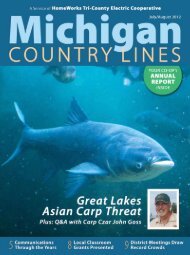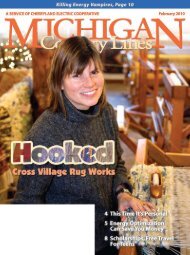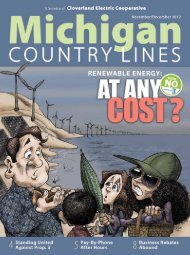Cherryland Electric Cooperative - Michigan Country Lines Magazine
Cherryland Electric Cooperative - Michigan Country Lines Magazine
Cherryland Electric Cooperative - Michigan Country Lines Magazine
Create successful ePaper yourself
Turn your PDF publications into a flip-book with our unique Google optimized e-Paper software.
HOUSE & HOME<br />
| James Dulley<br />
Pumping Up Efficiency<br />
A variety of heat pumps, from<br />
geothermal to standard air-source<br />
models, are available to efficiently<br />
heat and cool your home.<br />
Heat pumps are becoming a more<br />
common alternative to central air<br />
conditioners no matter what type<br />
of existing heating system you<br />
have. This is because a heat pump can also<br />
heat, as well as cool, your house efficiently.<br />
The cost of electricity for heating and cooling<br />
a house, although it gradually increases as<br />
most prices do over time, is much less volatile<br />
than natural gas, oil or propane.<br />
A geothermal heat pump is one of the most<br />
energy-efficient heating and cooling systems<br />
for any climate. Even though it provides a<br />
good long-term payback over its life on the<br />
investment, particularly in very hot or cold<br />
climates, the initial installation costs are<br />
considerably higher than for standard airsource<br />
models. Also, depending upon the<br />
yard and soil type, it may not be applicable<br />
for every house.<br />
A standard air-source heat pump is basically<br />
a central air conditioner with a few extra<br />
parts. The outdoor unit looks exactly the<br />
same as a central air conditioner. It is called<br />
a heat pump because it literally pumps heat<br />
out of your house (cooling mode) or into<br />
your house (heating mode) to or from the<br />
outdoor air around the outdoor compressor/<br />
condenser unit.<br />
During the summer, in the cooling mode,<br />
it draws heat from the indoor air as it passes<br />
through the indoor evaporator coils. Through<br />
a refrigeration cycle identical to an air conditioner,<br />
it expels this heat outdoors. The cooling<br />
efficiency is rated by its SEER (seasonal<br />
energy efficiency ratio). A heat pump’s cooling<br />
efficiency is only slightly less than its similar<br />
central air conditioner model.<br />
In winter, a reversing valve inside the heat<br />
pump outdoor unit switches position. This<br />
reverses the flow of the refrigerant throughout<br />
the entire system. Instead of running the cool<br />
refrigerant through the indoor coil, it runs<br />
the hot refrigerant indoors.<br />
The cold refrigerant is run outdoors, where<br />
it draws heat from the outside. Since the<br />
refrigerant is colder than the outdoor air, it<br />
absorbs heat even though the outdoor air may<br />
feel cold to you. Heating efficiency is rated by<br />
22 | <strong>Michigan</strong> <strong>Country</strong> <strong>Lines</strong><br />
This heat pump uses a modulating rotary compressor in a stainless steel exterior condenser unit.<br />
HSPF (heating seasonal performance factor).<br />
As it gets colder outdoors, it becomes more<br />
difficult for the heat pump to draw heat from<br />
the cold outdoor air just as the heating needs<br />
of your house increase. At a certain point, the<br />
heat pump can no longer provide enough heat<br />
to keep your house warm, and the backup<br />
heating source comes on. Depending upon<br />
the type of backup heat and relative energy<br />
costs, your heating/cooling contractor can<br />
set the temperature at which the backup<br />
takes over.<br />
There are many new developments in standard<br />
air-source heat pumps. The modulating,<br />
multistage output rotary compressor design,<br />
which was first introduced in central air conditioners,<br />
is now available in heat pumps. This<br />
design produces extremely high efficiencies<br />
for both heating and cooling (HSPF=10,<br />
SEER=22). You can get $2 to $3 worth of<br />
heat for each $1 on your utility bills.<br />
This heat pump uses a rotary compressor<br />
with inverter technology to vary its heating<br />
or cooling output from about one-third to<br />
full capacity output. This not only saves<br />
electricity, but produces great comfort, quiet<br />
operation, and even room temperatures. Twostage<br />
heat pumps also improve efficiency and<br />
comfort over standard single-stage models.<br />
Another new two-stage heat pump design<br />
couples a solar panel with the outdoor unit.<br />
On a sunny day, this solar panel produces<br />
enough electricity to operate the condenser<br />
fan for up to 8 percent electricity savings.<br />
When it is not sunny or at night, the outdoor<br />
condenser fan runs on electricity like<br />
any other heat pump.<br />
A standard low-cost, single-stage heat<br />
pump with a scroll compressor will still be<br />
efficient and provide comfort, especially when<br />
it is coupled with a variable-speed blower.<br />
Even if your indoor air handler seems to be<br />
working well, it should be replaced with one<br />
compatible with the new efficient outdoor<br />
unit. At the very least, the indoor evaporator<br />
coil should be replaced with a matching one.<br />
No matter what type of new heat pump<br />
you select, make sure your duct system is<br />
compatible with it. There should typically<br />
be from 400 to 500 CFM (cubic feet per<br />
minute) of air flow per ton of cooling through<br />
the unit for the best efficiency. Your old duct<br />
system may have to be modified.<br />
Have a question for Jim? Send inquiries to<br />
James Dulley, <strong>Michigan</strong> <strong>Country</strong> <strong>Lines</strong>, 6906<br />
Royalgreen Dr., Cincinnati, OH 45244, or<br />
visit dulley.com.<br />
James Dulley is a nationally<br />
recognized mechanical engineer<br />
writing about home energy<br />
issues for the National Rural<br />
<strong>Electric</strong> Cooperaive Association.<br />
Photo – Maytag

















